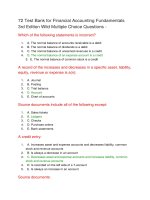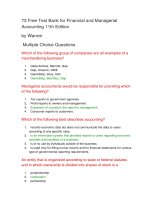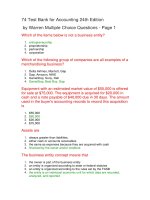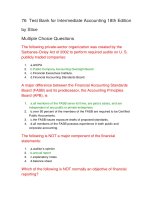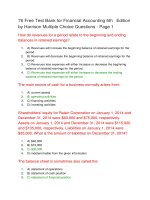72 test bank for financial accounting fundamentals 3rd editio1 đề trắc nghiệm có đáp án
Bạn đang xem bản rút gọn của tài liệu. Xem và tải ngay bản đầy đủ của tài liệu tại đây (97.01 KB, 17 trang )
72 Test Bank for Financial Accounting Fundamentals
3rd Edition
Wild Multiple
Choice Questions
The right side of a T-account is a(n):
1.
A. Debit
2.
B. Increase
3.
C. Credit
4.
D. Decrease
5.
E. Account balance
Which of the following statements is correct?
1.
2.
3.
A. The left side of a T-account is the credit side
B. Debits decrease asset and expense accounts and increase liability,
equity and revenue accounts
C. The left side of a T-account is the debit side
4.
D. Credits increase asset and expense accounts and decrease liability,
equity and revenue accounts
5.
E. In certain circumstances the total amount debited need not equal the
total amount credited for a particular transaction
Unearned revenues are:
1.
A. Revenues that have been earned and received in cash
2.
B. Revenues that have been earned but not yet collected in cash
3.
4.
C. Liabilities created when a customer pays in advance for products or
services before the revenue is earned
D. Recorded as an asset in the accounting records
5.
E. Increases to retained earnings
A list of all accounts used by a company and the identification
number assigned to each account is called a:
1.
A. Ledger
2.
B. Journal
3.
C. Trial balance
4.
D. Chart of accounts
5.
E. General Journal
Various types of documents and other papers that companies use
when they conduct their business:
1.
A. Are called source documents
2.
B. Can include sales tickets
3.
C. Are the source of information for recording accounting entries
4.
D. Can be in electronic form
5.
E. All of the above
A credit is used to record:
1.
A. An increase in an expense account
2.
B. An increase in an asset account
3.
C. An increase in an unearned revenue account
4.
D. An increase in a revenue account
5.
E. A decrease to retained earnings
Which of the following list of events properly reflects the early
steps taken in the accounting process?
1.
A. Record relevant transactions, Post journal information to ledger accounts
Analyze each transaction, Prepare and analyze the trial balance
2.
B. Post journal information to ledger accounts, Analyze each transaction,
Post journal information to ledger accounts, Prepare and analyze the trial
balance
3.
C. Prepare and analyze the trial balance, Analyze each transaction, Post
journal information to ledger accounts, Record relevant transactions
4.
D. Analyze each transaction, Post journal information to ledger accounts,
Record relevant transactions, Prepare and analyze the trial balance
5.
E. Analyze each transaction, Record relevant transactions, Post journal
information to ledger accounts, Prepare and analyze the trial balance
Which of the following statements is incorrect?
1.
A. The normal balance of accounts receivable is a debit
2.
B. The normal balance of dividends is a debit
3.
C. The normal balance of unearned revenues is a credit
4.
D. The normal balance of an expense account is a credit
5.
E. The normal balance of common stock is a credit
Double-entry accounting is an accounting system:
1.
A. That records each transaction twice
2.
B. That records the effects of transactions and other events in at least two
accounts with equal debits and credits
3.
C. In which the impact of each transaction is recorded in two or more
accounts but that could include two debits and no credits
4.
D. That may only be used if T-accounts are used
5.
E. That insures that errors never occur
A collection of all accounts (with account balances) used by a
business is called a:
1.
A. Journal
2.
B. Book of original entry
3.
C. General Journal
4.
D. Balance column journal
5.
E. Ledger
The general ledger of a business
1.
A. Is a collection of all accounts used in a company's information system
2.
B. Must be kept in a computer file
3.
C. A and B
4.
D. Is a set standard not affected by a company's size and diversity
5.
E. A, B and D
A simple account form widely used in accounting to illustrate how
debits and credits work is called a:
1.
A. Dividend account
2.
B. Common stock account
3.
C. Drawing account
4.
D. T-account
5.
E. Balance column sheet
A credit entry:
1.
2.
3.
A. Increases asset and expense accounts and decreases liability, common
stock and revenue accounts
B. Is always a decrease in an account
C. Decreases asset and expense accounts and increases liability, common
stock and revenue accounts
4.
D. Is recorded on the left side of a T-account
5.
E. Is always an increase in an account
Source documents include all of the following except:
1.
A. Sales tickets
2.
B. Ledgers
3.
C. Checks
4.
D. Purchase orders
5.
E. Bank statements
An asset created by prepayment of an expense is:
1.
A. Recorded as a debit to an unearned revenue account
2.
B. Recorded as a debit to a prepaid expense account
3.
C. Recorded as a credit to an unearned revenue account
4.
D. Recorded as a credit to a prepaid expense account
5.
E. Not recorded in the accounting records until the earnings process is
complete
Wisconsin Rentals purchased office supplies on credit. The
general journal entry made by Wisconsin Rentals will include a:
1.
A. Debit to Accounts Payable
2.
B. Debit to Accounts Receivable
3.
C. Credit to Cash
4.
D. Credit to Accounts Payable
5.
E. Credit to Retained Earnings
Of the following accounts, the one that normally has a credit
balance is:
1.
A. Cash
2.
B. Office Equipment
3.
C. Sales Salaries Payable
4.
D. Dividends
5.
E. Sales Salaries Expense
A debit is:
1.
A. An increase in an account
2.
B. The right-hand side of a T-account
3.
C. A decrease in an account
4.
D. The left-hand side of a T-account
5.
E. An increase to a liability account
A sales invoice:
1.
A. Is a type of use document
2.
B. Is used by sellers for recording purposes
3.
C. Is not needed by buyers
4.
D. Gives rise to an entry in the accounting process
5.
E. Is not necessary in accounting
Prepaid expenses are:
1.
A. Payments made for products and services that do not ever expire
2.
B. Classified as liabilities on the balance sheet
3.
C. Decreases in retained earnings
4.
D. Assets that represent prepayments of future expenses
5.
E. Promises of payments by customers
A debit is used to record:
1.
A. A decrease in an asset account
2.
B. A decrease in an expense account
3.
C. An increase in a revenue account
4.
D. An increase in the balance of common stock
5.
E. A decrease in the balance of retained earnings
The account used to record the transfers of assets from a
business to its stockholders is:
1.
A. A revenue account
2.
B. The retained earnings account
3.
C. Common stock account
4.
D. An expense account
5.
E. A liability account
An account balance is:
1.
A. The total of the credit side of the account
2.
B. The total of the debit side of the account
3.
C. The difference between the total debits and total credits for an account
including the beginning balance
4.
D. Assets = liabilities + equity
5.
E. Always a credit
Which of the following is a true statement regarding debits and
credits?
1.
A. If a company earned a profit, debits will not equal credits
2.
B. For a business, debits are better than credits
3.
C. A company's books are not in balance if they have a current period loss
4.
D. Assets and expenses are both increased with a debit
5.
E. Liabilities and equity are both increased with a debit
Management Services, Inc. provides services to clients. On May
1, a client prepaid Management Services $60,000 for 6-months
contract in advance. Management Services' general journal entry
to record this transaction will include a
1.
A. Debit to Unearned Management Fees for $60,000
2.
B. Credit to Management Fees Earned for $60,000
3.
C. Credit to Cash for $60,000
4.
D. Credit to Unearned Management Fees for $60,000
5.
E. Debit to Management Fees Earned for $60,000
A record of the increases and decreases in a specific asset,
liability, equity, revenue or expense is a(n):
1.
A. Journal
2.
B. Posting
3.
C. Trial balance
4.
D. Account
5.
E. Chart of accounts
Source documents:
1.
A. Include the ledger
2.
B. Are the sources of accounting information
3.
C. Must be in electronic form
4.
D. Are based on accounting entries
5.
E. Include the chart of accounts
An account used to record the owner's investments in the
business is called:
1.
A. Dividends
2.
B. Common Stock
3.
C. Revenue
4.
D. Expense
5.
E. Liability
The accounting process begins with:
1.
A. Analysis of business transactions and events
2.
B. Preparation of financial statements and other reports
3.
C. Summarizing the recorded effects of business transactions
4.
D. Presentation of financial information to decision-makers
5.
E. Preparation of the trial balance
Which of the following statements is correct?
1.
2.
A. When a future expense is paid in advance, the payment is normally
recorded in a liability account called Prepaid Expense
B. Promises of future payment are called accounts payable
3.
C. Increases and decreases in cash are always recorded in the retained
earnings account
4.
D. An account called Land is commonly used to record increases and
decreases in both the land and buildings owned by a business
5.
E. Accrued liabilities include accounts receivable
Which of the following statements about the Cash account is
true?
1.
A. Because most companies earn their fees in cash, the cash account is
categorized as revenue
2.
B. For any given transaction Accounts Receivable and Cash can be used
interchangeably because both accounts are measured in terms of cash
3.
C. The cash account includes the value of any medium of exchange that a
bank accepts for deposit
4.
D. Both A and B are true statements
5.
E. Both B and C are true statements
For what reason do most sellers require customers to have their
receipts in order to exchange or return purchased items?
1.
A. The receipt contains coded information which the seller needs to prepare
and analyze the trial balance.
2.
B. Sellers wish to ensure that the sale in question was rung up on the
register in the first place.
3.
C. This is a legal requirement mandated by a federal law.
4.
D. The receipt is serving as a promissory note.
5.
E. To create an environment in which customer's do not want to return
items.
A liability created by the receipt of cash from customers in
payment for products or services that have not yet been delivered
to the customers is:
1.
A. Recorded as a debit to an unearned revenue account
2.
B. Recorded as a debit to a prepaid expense account
3.
C. Recorded as a credit to an unearned revenue account
4.
D. Recorded as a credit to a prepaid expense account
5.
E. Not recorded in the accounting records until the earnings process is
complete
Rocky Industries received its telephone bill in the amount of $300
and immediately paid it. Rocky's general journal entry to record
this transaction will include a
1.
A. Debit to Telephone Expense for $300
2.
B. Credit to Accounts Payable for $300
3.
C. Debit to Cash for $300
4.
D. Credit to Telephone Expense for $300
5.
E. Debit to Accounts Payable for $300
A written promise to pay a definite sum of money on a specific
future date is a(n):
1.
A. Unearned revenue
2.
B. Prepaid expense
3.
C. Credit account
4.
D. Note payable
5.
E. Account receivable
A ledger is:
1.
2.
3.
4.
5.
A. A record containing increases and decreases in a specific asset, liability,
equity, revenue or expense item
B. A journal in which transactions are first recorded
C. A collection of documents that describe transactions and events during
the accounting process
D. A list of all accounts with their debit balances at a point in time
E. A list of all accounts a company uses and includes an identification
number assigned to each account
72 Free Test Bank for Financial Accounting
Fundamentals 3rd Edition Wild Multiple Choice
Questions - Page 2
The credit purchase of a delivery truck for $4,700 was posted to
Delivery Trucks as a $4,700 debit and to Accounts Payable as a
$4,700 debit. What effect would this error have on the trial
balance?
1.
A. The total of the Debit column of the trial balance will exceed the total of
the Credit column by $4,700
2.
B. The total of the Credit column of the trial balance will exceed the total of
the Debit column by $4,700
3.
C. The total of the Debit column of the trial balance will exceed the total of
the Credit column by $9,400
4.
D. The total of the Credit column of the trial balance will exceed the total of
the Debit column by $9,400
5.
E. The total of the Debit column of the trial balance will equal the total of the
Credit column
The record in which transactions are first recorded is the:
1.
A. Account balance
2.
B. Ledger
3.
C. Journal
4.
D. Trial balance
5.
E. Cash account
On September 30, the Cash account of Value Company had a
normal balance of $5,000. During September, the account was
debited for a total of $12,200 and credited for a total of $11,500.
What was the balance in the Cash account at the beginning of
September?
1.
A. A $0 balance
2.
B. A $4,300 debit balance
3.
C. A $4,300 credit balance
4.
D. A $5,700 debit balance
5.
E. A $5,700 credit balance
6.
Normal balance = debit
In which of the following situations would the trial balance not
balance?
1.
A. A $1,000 collection of an account receivable was erroneously posted as
a debit to Accounts Receivable and a credit to Cash
2.
B. The purchase of office supplies on account for $3,250 was erroneously
recorded in the journal as $2,350 debit to Office Supplies and credit to
Accounts Payable
3.
C. A $50 cash receipt for the performance of a service was not recorded at
all
4.
D. The purchase of office equipment for $1,200 was posted as a debit to
Office Supplies and a credit to Cash for $1,200
5.
E. The cash payment of a $750 account payable was posted as a debit to
Accounts Payable and a debit to Cash for $750
Which of the following statements is true?
1.
A. If the trial balance is in balance, it proves that no errors have been made
in recording and posting transactions
2.
B. The trial balance is a book of original entry
3.
C. Another name for trial balance is chart of accounts
4.
D. The trial balance is a list of all accounts from the ledger with their
balances at a point in time
5.
E. The trial balance is another name for the balance sheet as long as debits
balance with credits
Which of the following statements is incorrect?
1.
A. Higher financial leverage involves higher risk
2.
B. Risk is higher if a company has more liabilities
3.
C. Risk is higher if a company has higher assets
4.
D. The debt ratio is one measure of financial risk
5.
E. Lower financial leverage involves lower risk
Listed below are two pieces of information. Where is the best
place to locate this information, in the journal or the ledger?
Details of a transaction which took place on October 3rd. All of
the sales activity which took place during the current month
1.
A. 1. Journal 2. Journal
2.
B. 1. Journal 2. Ledger
3.
C. 1. Ledger 2. Ledger
4.
D. 1. Ledger 2. Journal
5.
E. This information is only available on the financial statements
On November 30, a company had an Accounts Receivable
balance of $5,100. During the month of December, total credits to
Accounts Receivable were $76,000 from customer payments.
The December 31 Accounts Receivable balance was $43,000.
What was the amount of credit sales during December?
1.
A. $8,100
2.
B. $27,900
3.
C. $70,900
4.
D. $76,000
5.
E. $113,900
6.
Normal balance = debit
Which of the following statements is false with regard to the debt
ratio?
1.
A. It is of use to both internal and external users of accounting information
2.
B. A relatively high ratio is always desirable
3.
C. The dividing line for a high and low ratio varies from industry to industry
4.
D. Many factors such as the company's age, stability, profitability and cash
flow influence the determination of what would be interpreted as a high
versus a low ratio
5.
E. The ratio might be used to help determine if a company is capable of
increasing its income by obtaining further debt
According to IFRSs, comparative information on financial
statements is:
1.
A. Not required
2.
B. Required for publicly traded companies only
3.
C. Required for the preceding period only
4.
D. Required for the last five years
5.
E. Not required, but considered a hallmark for companies of excellence
A $72,000 receipt of cash from a customer paying on their
account was recorded as a $72,000 debit to Accounts
Receivable. Assuming this journal entry was posted, what
correcting entry (if any) is needed?
1.
A. Debit Cash and Credit Accounts Receivable for $72,000 each
2.
B. Debit Cash and Credit Accounts Receivable for $144,000 each
3.
C. Credit Cash and Debit Accounts Receivable for $72,000 each
4.
D. Credit Cash and Debit Accounts Receivable for $144,000 each
5.
E. No correcting entry is needed for this transaction
A balance column ledger account is:
1.
2.
3.
A. An account entered on the balance sheet
B. An account with debit and credit columns for posting entries and another
column for showing the balance of the account after each entry is posted
C. An alternate name for the retained earnings account
4.
D. An account used to record the transfers of assets from a business to its
stockholders
5.
E. A simple form of account that is widely used in accounting to illustrate
the debits and credits required in recording a transaction
Which of the following formulas can be used to calculate the debt
ratio?
1.
A. Total Equity/Total Liabilities
2.
B. Total Liabilities/Total Equity
3.
C. Total Liabilities/Total Assets
4.
D. Total Assets/Total Liabilities
5.
E. Total Equity/Total Assets
During the month of February, Hoffer Company had cash receipts
of $7,500 and cash disbursements of $8,600. The February 28
cash balance was $1,800. What was the January 31 beginning
cash balance?
1.
A. $700
2.
B. $1,100
3.
C. $2,900
4.
D. $0
5.
E. $4,300
6.
X + $7,500 - $8,600 = $1,800
Of the following errors, which one on its own will cause the trial
balance to be out of balance?
1.
A. A $200 cash salary payment posted as a $200 debit to Cash and a $200
credit to Salaries Expense
2.
B. A $100 cash receipt from a customer in payment of his account posted
as a $100 debit to Cash and a $10 credit to Accounts Receivable
3.
C. A $75 cash receipt from a customer in payment of his account posted as
a $75 debit to Cash and a $75 credit to Cash
4.
D. A $50 cash purchase of office supplies posted as a $50 debit to Office
Equipment and a $50 credit to Cash
5.
E. An $800 prepayment from a customer for services to be rendered in the
future was posted as an $800 debit to Unearned Revenue and an $800
credit to Cash
A company had the following account balances at year-end: If all
of the accounts have normal balances, what are the totals for the
trial balance?
1.
A. $45,200
2.
B. $67,000
3.
C. $104,800
4.
D. $209,600
5.
E. $186,600
The process of transferring general journal information to the
ledger is:
1.
A. Double-entry accounting
2.
B. Posting
3.
C. Balancing an account
4.
D. Journalizing
5.
E. Not required unless debits do not equal credits
A trial balance taken at year-end showed total credits exceeding
total debits by $4,950. This discrepancy could have been caused
by:
1.
2.
A. An error in the general journal where a $4,950 increase in Accounts
Receivable was recorded as an increase in Cash
B. A net income of $4,950
3.
C. The balance of $49,500 in Accounts Payable being entered in the trial
balance as $4,950
4.
D. The balance of $5,500 in the Office Equipment account being entered on
the trial balance as a debit of $550
5.
E. An error in the general journal where a $4,950 increase in Accounts
Payable was recorded as a decrease in Accounts Payable
The debt ratio is used:
1.
A. To measure the amount of equity relative to the expenses
2.
B. To reflect the risk associated with a company's debts
3.
C. Only by banks when a business applies for a loan
4.
D. To determine how much debt a firm should pay off
5.
E. To determine who a company owes
A column in journals and ledger accounts used to cross reference
journal and ledger entries is the:
1.
A. Account balance column
2.
B. Debit column
3.
C. Posting reference column
4.
D. Credit column
5.
E. Description column
A report that lists accounts and their balances, in which the total
debit balances should equal the total credit balances is called
a(n):
1.
A. Account balance
2.
B. Trial balance
3.
C. Ledger
4.
D. Chart of accounts
5.
E. General Journal
A general journal is:
1.
A. A ledger in which amounts are posted from a balance column account
2.
B. Not required if T-accounts are used
3.
C. A complete record of each transaction in the place from which
transaction amounts are posted to the ledger accounts
4.
D. Not necessary in electronic accounting systems
5.
E. A book of final entry because financial statements are prepared from it
On April 30, Holden Company had an Accounts Receivable
balance of $18,000. During the month of May, total credits to
Accounts Receivable were $52,000 from customer payments.
The May 31 Accounts Receivable balance was $13,000. What
was the amount of credit sales during May?
1.
A. $5,000
2.
B. $47,000
3.
C. $52,000
4.
D. $57,000
5.
E. $32,000
6.
Normal balance = debit
Accountants at Amalgamated Corporation incorrectly journalized
a $50,000 equipment purchase as a debit to Buildings. This error
was not discovered before the journal entry was posted. What is
the correcting entry?
1.
A. Debit Buildings and Credit Equipment for $50,000 each
2.
B. Debit Equipment and Credit Buildings for $50,000 each
3.
C. Debit Buildings and Credit Equipment for $100,000 each
4.
D. Debit Equipment and Credit Buildings for $100,000 each
5.
E. Debit Equipment for $100,000 and Credit Buildings for $50,000
Stride Rite has total assets of $425 million. Its total liabilities are
$110 million. Its equity is $315 million. Calculate the debt ratio.
1.
A. 38.6%
2.
B. 13.4%
3.
C. 34.9%
4.
D. 25.9%
5.
E. 14.9%
6.
$110/$425 = 25.9%
A $15 credit to Sales was posted as a $150 credit. By what
amount is Sales in error?
1.
A. $150 understated
2.
B. $135 overstated
3.
C. $150 overstated
4.
D. $15 understated
5.
E. $135 understated
During March, a company had cash receipts of $2,300 and cash
disbursements of $6,600. The March 31 cash balance was
$2,780. What was the March 1 beginning cash balance?
1.
A. $1,520
2.
B. $7,080
3.
C. $4,300
4.
D. $8,900
5.
E. $11,680
6.
X + $2,300 - $6,600 = $2,780
A company has total liabilities of $550 million and total equity of
$300 million. Calculate this company's debt ratio.
1.
A. 64.7%
2.
B. 100%
3.
C. 54.5%
4.
D. 1.83 to 1
5.
E. The debt ratio cannot be determined without additional information
6.
$550/($550 + $300) = 64.7%
What is another name for the general journal?
1.
A. The book
2.
B. The ledger
3.
C. The book of original entry
4.
D. The record
5.
E. The account book
If the Debit and Credit column totals of a trial balance are equal,
then:
1.
A. All transactions have been recorded correctly
2.
B. All entries from the journal have been posted to the ledger correctly
3.
C. All ledger account balances are correct
4.
D. The total debit entries and total credit entries are equal
5.
E. The balance sheet would be correct
On October 31, a company's Cash account had a normal balance
of $7,000. During October, the account was debited for a total of
$4,250 and credited for a total of $5,340. What was the balance in
the Cash account at the beginning of October?
1.
A. $0 balance
2.
B. $1,090 debit balance
3.
C. $2,590 credit balance
4.
D. $8,090 debit balance
5.
E. $9,590 credit balance
6.
Normal balance = debit
A company has total assets of $385 million. Its total liabilities are
$100 million and its equity is $285 million. Calculate its debt ratio.
1.
A. 35.1%
2.
B. 26.0%
3.
C. 38.5%
4.
D. 28.5%
5.
E. 58.8%
6.
$100/$385 = 26.0%
The Fireside Country Inn is a very popular destination for tourists.
The Inn requires guests to make reservations at least two months
in advance of their stay. A twenty percent down payment is
required at the time the reservation is made. When should this inn
recognize room rental revenue?
1.
A. On the date the reservation is received
2.
B. On the date the money for the reservation is received
3.
C. On the date the guests stay in the inn
4.
D. On the date the guests pay the remaining eighty percent due
5.
E. Once all cash has been received
Jones Hardware, Inc. pays a cash dividend of $6,000, what is the
necessary entry to record this transaction?
1.
A. Debit Cash, Credit Retained Earnings
2.
B. Debit Dividends, Credit Cash
3.
C. Debit Common Stock, Credit Cash
4.
D. Debit Cash, Credit Common Stock
5.
E. Debit Cash, Credit Dividend Income
A $130 credit to Office Equipment was credited to Fees Earned
by mistake. By what amounts are the accounts under or
overstated as a result of this error?
1.
A. Office Equipment, understated $130; Fees Earned, overstated $130
2.
B. Office Equipment, understated $260; Fees Earned, overstated $130
3.
C. Office Equipment, overstated $130; Fees Earned, overstated $130
4.
D. Office Equipment, overstated $130; Fees Earned, understated $130
5.
E. Office Equipment, overstated $260; Fees Earned, understated $130
A company failed to post a $50 debit to the Office Supplies
account. The effect of this error will be that:
1.
A. The Office Supplies account balance will be overstated
2.
B. The trial balance will not balance
3.
C. The error will overstate the debits listed in the journal
4.
D. The total debits in the trial balance will be larger than the total credits
5.
E. All of the above effects will be caused by the error



